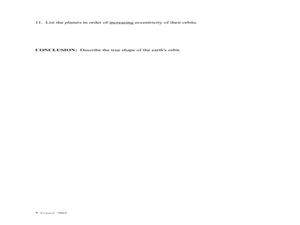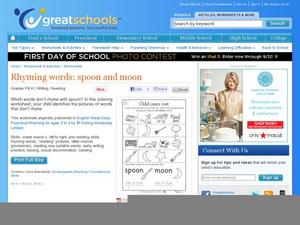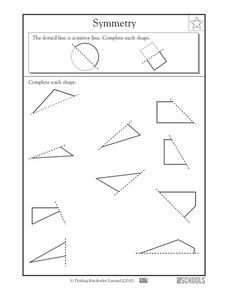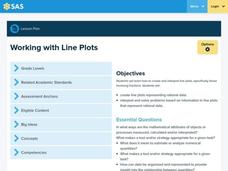Curated OER
Ellipse Lab
Leading the learners to draw a representation of ellipses of planets, this handout will help understanding the planet movement around the sun. There are ten questions about the analysis of those orbits and a conclusino specifically...
Curated OER
Rhyming Words: Spoon and Moon
One of these things is not like the other, one of these things does not belong. It's true! Little learners will say each of the four words in each of four rows, to determine which one does not rhyme with the others. After that, they...
Curated OER
Symmetry
Enhance your geometry lesson by working with shapes. Fourth graders follow lines of symmetry to complete ten shapes, most of them currently triangles. Have pupils color each half of their shapes to reinforce the idea of symmetry!
Curated OER
Counting Dice
Using dice is a great way to practice addition in this simple worksheet. Young learners examine three rolls of two dice each. They add the values of each die, writing an addition problem with an answer. There is an example for them to...
Curated OER
Scissor Skills
In this scissor skills worksheet, students practice cutting from one point to another. Students will be cutting along a variety of line shapes for dexterity practice. Next, students cut our fish and glue onto the tank that has the same...
Curated OER
Valentine Sorting Activity
Get that thinking cap on and engage your special ed or autistic learners in a fun sorting activity. This resource includes instructions and all printable materials needed to start sorting. They will sort colors blue and red, numbers 1,...
Curated OER
Odd Ones Out
Some of these words don't rhyme; scholars determine which ones as they examine four sets of images with the vowel sound /e/. For each set, they circle the words that don't rhyme with the first image. Be sure kids know what these images...
Curated OER
Conversation & Grammar: Future Tenses
This eBook, part of a series devoted to instruction for grammar and conversation, focuses on the future tenses—the future simple, future continuous, future perfect, and future perfect continuous in positive, negative, and question forms.
Mathematics Vision Project
Module 9: Modeling Data
How many different ways can you model data? Scholars learn several in the final module in a series of nine. Learners model data with dot plots, box plots, histograms, and scatter plots. They also analyze the data based on the data...
Curated OER
Street Cows
A light, and humorous lesson on "street cows" is here for you. Learners listen to the story, "Street Cows," which is embedded in the plan. On a map of the US and the World, they locate the cities where the "Cows on Parade" exhibit was...
Curated OER
Sight Words Practice
Just cut along the dotted line and you've got sight word flashcards! Intended for new readers, these 2 and 3-letter words will become familiar the more your learner sees them. There are tweleve words in all. Be sure to shuffle you...
Hawaiʻi State Department of Education
Mask Symmetry
When you engage learners in creating symmetrical objects you are also building their vocabulary and math sense. Kids discuss key words such as, asymmetrical, symmetrical, balance, tint, and shade. They use these elements of design to...
EngageNY
Expected Value of a Discrete Random Variable
Discover how to calculate the expected value of a random variable. In the seventh installment of a 21-part module, young mathematicians develop the formula for expected value. They connect this concept the dot product of vectors.
Curated OER
How Does the Air Get Polluted?
Students listen to or read a story that introduces awareness of environmental issues and in particular pollution.
Curated OER
Measuring Volume/Capacity Using the Metric System
There is more than one way to measure an amount, as learners discover by applying multiple measurement tools in these activities. Centimeter cubes, cylinders, beakers, and measuring cups are used to find the volume of regular and...
Curated OER
Volume, Mass, and Weight
Study the difference between mass and weight. Your math group will compare the weight of an item to the amount of space that it uses. They'll then use conversion factors to find the difference between kilograms and pounds. Essential...
Other popular searches
- Dot to Dot Worksheets
- Dot to Dot Puzzle
- Alphabet Dot to Dot
- Dot to Dot Picture
- Halloween Dot to Dot Picture
- Dinosaur Dot to Dot
- Duck Dot to Dot
- Dot to Dot 1 30
- Cat Dot to Dot
- Number Dot to Dot
- Dot to Dot Fish
- Dot to Dot Heroes















